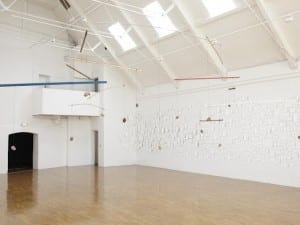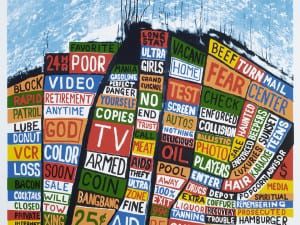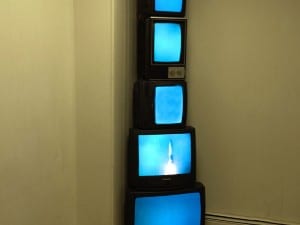The Walker Art Center’s latest exhibition, 9 Artists, strips the concept of group show down to its core, dispensing with themes and showcasing the work of artists practising today.
Bartholomew Ryan, curator of 9 Artists, acknowledges that “the title, of course, has a kind of neutrality in relation to a theme, and looks back to group show precedents, where things were more matter of fact,” but he emphasises that, historically, group shows have had “this sense of inevitability; an arrogance almost that was naming a shift in a seemingly understated way.” The idea of recreating such a show was thus attractive because “we no longer think in terms of progress from one kind of art making to another, but have to negotiate these multiple perspectives at all times.” And the multiple perspectives of today’s art world are manifested in this exhibition precisely because the 9 Artists show features only eight named artists, raising unanswerable speculation among quizzical viewers over who is the ninth: “A lot of people will think the ninth artist is the curator, a figure who is increasingly criticised for annexing artistic authorship, but I prefer to think that this artist might be every other artist who could have been in the show, or one of the many ghosts that haunts the exhibition. It’s like we are setting a place in case Elijah shows up for dinner; it could also be the viewers who, in classic contemporary art style, are invited to become participants in making the work.”
The show’s designation is deliberately confusing, but Ryan sees these mixed messages as “not that important.” He toyed with the idea of adding another artist but “they weighted the exhibition too much in another direction; made it too legible along some art-historical trajectory.” Satisfied with the original eight, the title became a ploy to emphasise the exhibition’s very nature: “If the exhibition is about anything, it is about not trumpeting a literal transparent read of the world.” The selected artists all maintain expansive practices, and the show explores how they individually address questions of biography and identity while negotiating an increasingly complex and connected world. Ryan explains: “I was interested in playing with the fact that we no longer think in terms of progress from one kind of art making to another, but have to negotiate multiple perspectives at all times.”
Encompassing sculpture, music, video and performance, 9 Artists is an eclectic representation of art production today, and the absence of themes was “challenging at all stages in that I didn’t want to over-articulate a theme for the institution, for the artists themselves, or more broadly.” Although commonalities are still emerging and “will play out in the installation and in the catalogue,” Ryan sees the idea as a whole as “pretty compelling; it will have a lot of tension and hopefully even chemistry.”
While the exhibition claims as broad a remit as “the mutable role of the artist in contemporary culture,” the selection of artists was a natural one: “I basically started with eight artists whose work I thought would be interesting together; who I thought approached some of the same broad questions but came at them from very different positions.” In contrast to more contrived group shows, and their laboured sense of drawing the artists together, Ryan refreshingly admits that his initial selection was as simple as “writing names down on a piece of paper. These are all artists whose work I have found challenging in the past, sometimes frustrating, deeply problematic, or provocative. They are artists whose work I think of almost on a daily basis, who I wanted to know more about and think about in relation to each other.” This very personal preoccupation of the curator suggests that perhaps he is the ninth artist, and the Walker Art Center faces a challenge of appealing to a wider audience who might not share Ryan’s intrigue. In spite of openly admitting to such a personal collection, however, Ryan does identify a theme of sorts, albeit a broad one that is not immediately obvious on traversing the works: “At the core of the exhibition is an exploration of what it means to be self-aware, to acknowledge and understand that we are in a world where, in order to navigate anything, you must confront your own complicity and implication in power. For me, what each of the artists has in common is a very basic thing: they can perceive themselves moving in the world.” Of course, it can be argued that Ryan himself is turning a blind eye to the implications of his own power in selecting the artists, but the works involved do raise pertinent questions about self and biography that have been sidelined in recent years and deemed unfashionable among art critics.
In spite of, or perhaps because of this, Ryan is suspicious of such generalisations: “Words like ‘identity’ and ‘biography’ are very loaded in the art world, in fact I think we live under the shadow of many words and terms that are no longer that serviceable for describing or engaging with the present because they come with so much baggage.” He criticises “the chimera of identity politics” and its orthodox reading as a specific moment by arguing that “we should know that identity politics are everywhere all the time, and we are all participants.” Grouping the artists together, they are all “aware of the questions that come along with these really overburdened ideas, and don’t think they have to abandon identity or biography – they just don’t have to talk about them in the ways we used to.”
Danh Vo’s (b. 1975) absolute granite sculpture, Tombstone for Phùng Vo (2010), is an intensely personal piece installed in the Minneapolis Sculpture Garden which will be removed on his father’s death to be placed on his grave at Vestre Kirkegård in Copenhagen. By aligning the museum’s collection with such a personal (and uncontrollable) element of the artist’s life, Vo has made his family and biography implicit in the future of the museum’s outdoor space. In visiting the sculpture, audiences cannot help but identify with the issues of fear and loss that it raises, and Ryan says: “There is something beautiful about the way Danh’s father has become a participant in his work.” As Phùng Vo created the piece’s calligraphy (“Here Lies One Whose Name Was Writ In Water,” taken from Keats’ grave), the piece is an almost macabre memento mori from son to father, highlighting “a certain perversity that is key to Danh’s work, almost a malevolence in terms of bureaucratic processes that shouldn’t be ignored.” Vo, who escaped Vietnam for Denmark with his father as a child, is an artist whose biography is (as here) inevitably referenced by anybody discussing his work, and Ryan describes this as a “kind of foundation myth as productive for Vo as Joseph Beuys’ rescue by the Tartars was for him,” and consequently this biographical element emphasises his family’s role in his work, and his father’s ultimate destiny to rest “in exile.” 9 Artists also includes a new presentation of the artist’s exhibition I M U U R 2 (2012), which is based on the personal archive of deceased Lower East Side painter Martin Wong and was developed over many years in collaboration with his mother, Florence Wong.
In complete contrast to Vo, Natascha Sadr Haghighian (b. 1968) dismisses biography and history altogether, “famously founding a website for the free exchange of bios and resumes because she felt the whole idea of ascribing value according to biographical background, or the institutional affiliations that one lists on a CV, for example, is deeply suspect and often about a form of containment and control.” Haghighian’s contribution includes a new commission based around the artist’s appeal to ArtFacts.net to cease their biographical accounts of her career and exhibiting history, and ranking her amongst the international artist community. The project is inherently intangible and abstract, and naturally poses issues for its transmission to an audience, but Ryan emphasises that “she doesn’t do this just for the sake of it; she understands that the nature of the invitation can also be highly prescriptive. In my first conversation with her she said she wishes she could be more proactive than reactive, but that often she just can’t help it because the terms of engagement are so confining or problematic.” Her I can’t work like this (2007), also featured, is the deserted wall installation of a frustrated artist, literally downing tools and abandoning the piece due to the constraints of the “industry”, and it’s a piece that naturally engages with the space (and unwittingly perhaps with the institution).
In response to popular culture’s seemingly insatiable appetite for reality TV and consistently more intimate, more shocking revelations, Bjarne Melgaard’s (b. 1967)The awakening and consumption of Heidi Fleiss as she talks to a brioche named Austin (2013) caricatures this fascination with C-list celebrities with slightly unsavoury pasts, such as the infamous Hollywood Madam, and the voyeurism that such TV shows enjoy over their mundane activities. The work comprises hundreds of documentary photographs of Melgaard by Johannes Worsøe Berg depicting “the artist in his studio, strolling around New York in the rain, hanging out at the Eagle, or on a water taxi in Venice.” Ryan describes the work as “fairly cinematic,” and compares it to the romantic films of Wong Kar-Wai and to Before Sunset (2004).
However, rather than creating a no-holds-barred portrait of the artist, Melgaard engages with the persona of the artist and the idea of biography as a construct and a performance. As Melgaard’s work “sets this apparently biographical larger-than-life body and figure in play, you are never quite sure if you are dealing with Bjarne or some excessive version of his artistic persona. It is quite easy to burlesque him, but I think his work rewards strong concentration.” In the exhibition, Melgaard’s work most obviously engages with Ryan’s argument that what these artists represent “is always shifting, not just for the sake of it, but because they recognise identity as highly contextual.” As an artist, musician and writer, Melgaard’s work defies categorisation, but his pieces in 9 Artists are some of the most collaborative of the exhibition, involving not just Worsøe Berg but also Ryan himself, who says: “This work really emerged out of our conversations around some of the exhibition ideas,” and it came together “after many meetings with the artist.”
This idea of collaboration extends to the 9 Artists catalogue, which sees each artist working with another creative individual through text and images to engage with new issues of identity and biography. For example, Vo’s deeply personal repertoire is extended with images of his nephew, Gustav, and “a text by artist Karl Holmqvist that has been written out by Phùng Vo,” while Israeli artist Yael Bartana (b. 1970) engages further with the competing Diasporic and Zionist identities of her home country through “a series of letters between herself and the notorious Austrian philosopher and anti-Semite Otto Weininger.” The fact that the letters are ghost written by her long-term collaborator, Galit Eilat, alongside the fact that many of Melgaard’s photographs were taken by Worsøe Berg, further draws into question the nature of art and the role of authorship for artists’ own works. This debate, and the concept of intellectual property rights, are further explored by Hito Steyerl’s (b. 1966) contribution, I Dreamed a Dream: Politics in the Age of Mass Art Production (2013), which became a fortuitous and unintentional conversation “between her, the Walker and a rights holder who withheld copyright for the reprint of a song.” The text-based piece highlights the void left by the artist’s decision to reject the Walker Art Center’s argument for fair use in printing the song, and serves as a sort of anti-collaboration.
Meanwhile, Nástio Mosquito (b. 1981) has taken a wry look at the very concept of concepts and art’s perpetually introspective attitude, collaborating with Vic Pereiró on “a super graphic visual and DIY style” response to Ryan’s questions which “make some very elegant points.” The text offers a substantial insight into the artistic community today, and its constant battle with itself and its history, with an essay from Ryan on “the army of individuals” (itself a quote from Mosquito), “in which I try to contend a little with each artist’s work, while also more or less refusing to connect them to each other aggressively.” He summarises: “It’s going to be an odd and beautiful publication,” a description which aptly describes the whole role of art production today.
9 Artists runs from 24 October to 16 February at the Walker Art Center, Minneapolis. www.walkerart.org.
Ruby Beesley





